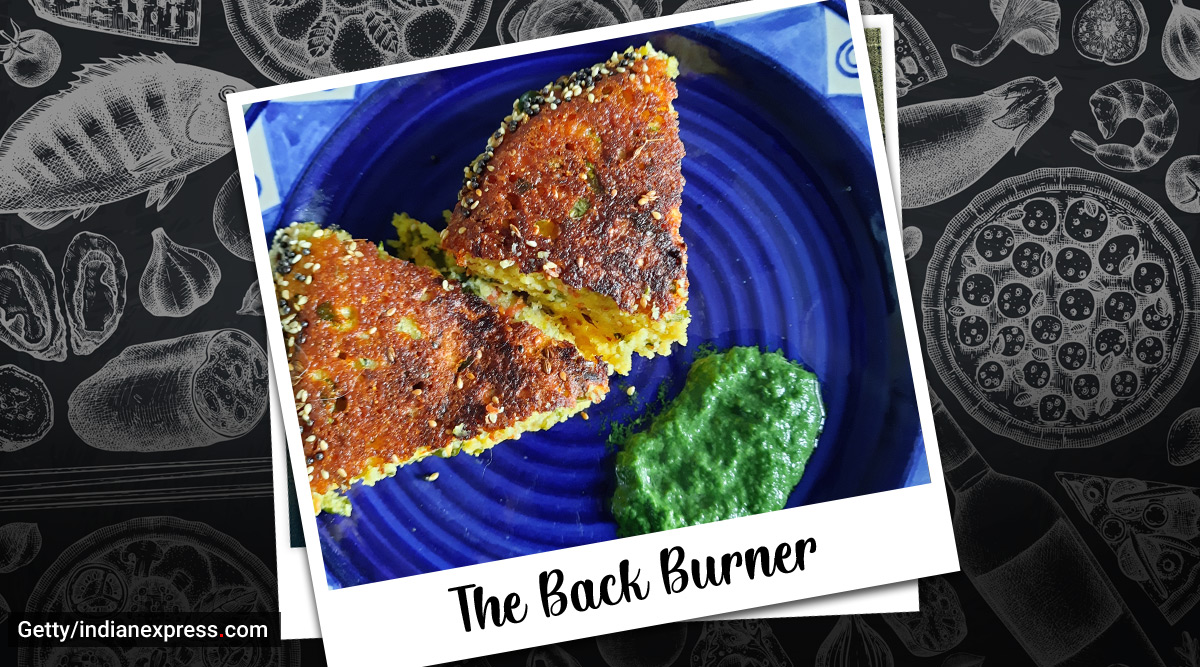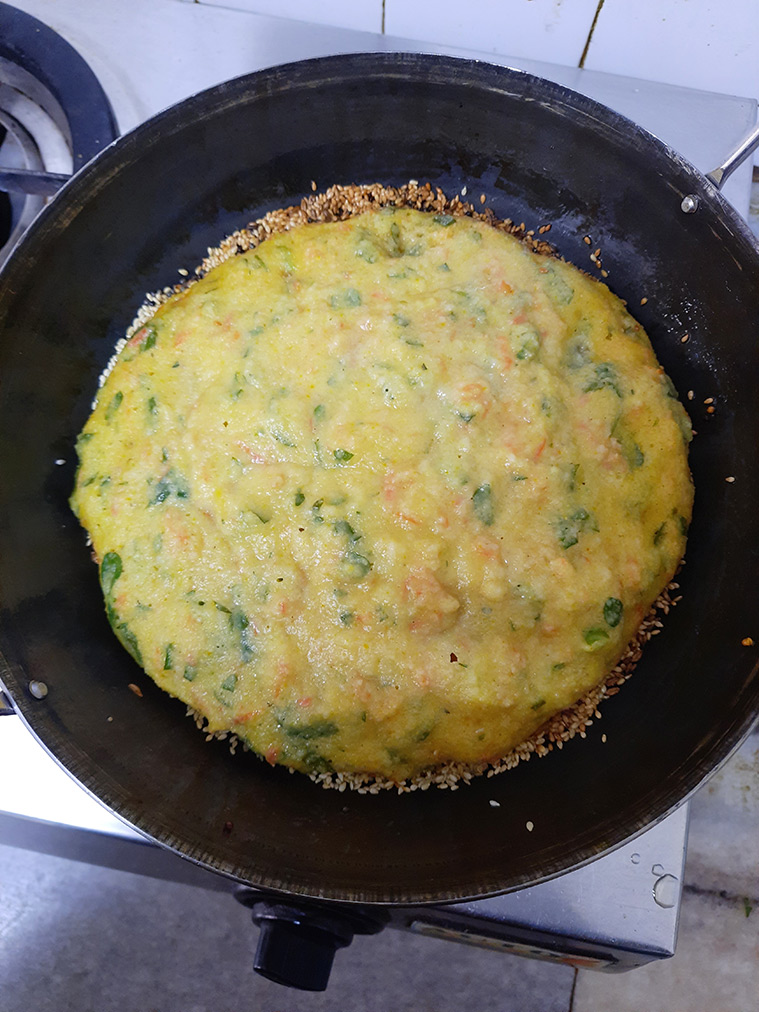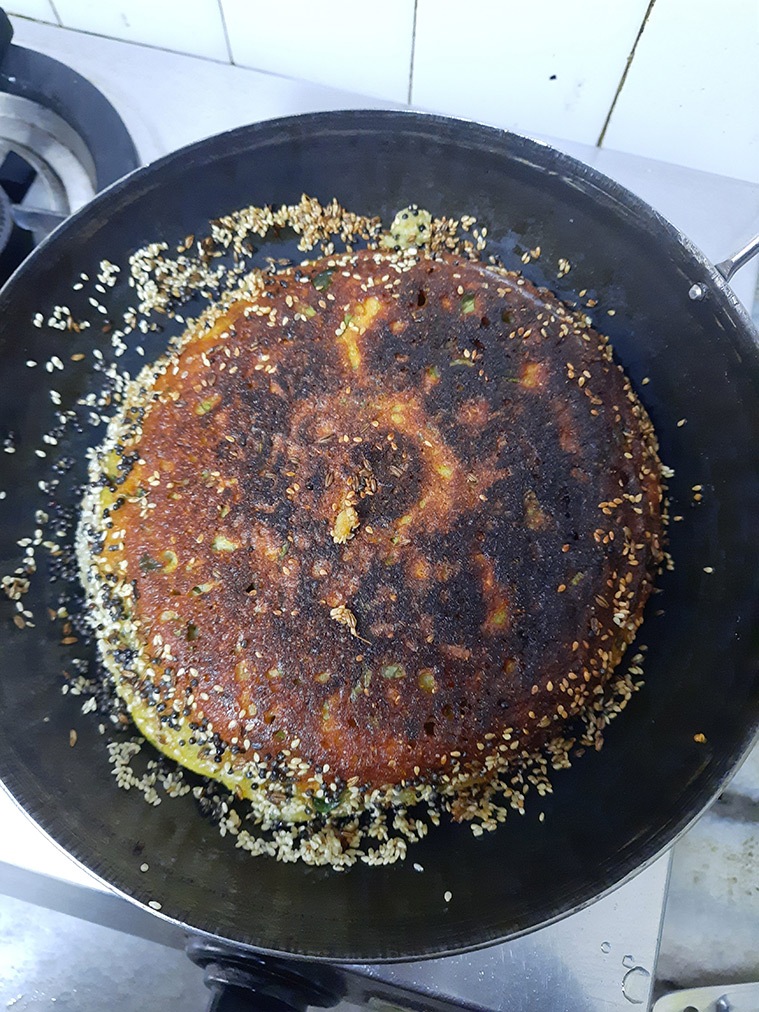 Family fights have begun over who gets to eat more of handvo’s gorgeous, crunchy crust. (Photo credit: Pooja Pillai)
Family fights have begun over who gets to eat more of handvo’s gorgeous, crunchy crust. (Photo credit: Pooja Pillai) The most accurate description for handvo is the one given to me by a Gujarati friend, back when we were both kids: khaatto cake or tangy/savoury cake. This personal favourite preparation does look like cake – and, traditionally, it is made in vessels that look a lot like bundt pans. But it can also be made in a wok or a frying pan and many households do exactly that.
It looks like cake but, of course, handvo is nothing like cake. It’s made of a batter of different dals and rice, which is fermented and, after the addition of some vegetables and spices, cooked until it gets the golden, crunchy crust that it is most loved for. I’ve heard my Gujarati friends joke about the fights that break out at the table whenever handvo is on the menu, because everyone thinks that everyone else but them has got a lot of the crust. It’s that good.
The most popular version of handvo uses grated bottlegourd (which, honestly, is the best use of this miserable vegetable). But feel free to experiment with other vegetables: carrots, peas and cabbage are the safest choices to begin with, but you can also experiment with beetroot, spinach and sweet corn and, if you’re feeling really adventurous, radish and bitter gourd (but NOT together). Just remember to balance the flavours.
 The perfect handvo has a light, airy crumb and a thick, crisp crust. (Photo credit: Pooja Pillai)
The perfect handvo has a light, airy crumb and a thick, crisp crust. (Photo credit: Pooja Pillai)
Since it’s winter and my favourite leafy green veggie – fresh fenugreek aka methi – is abundantly available, I decided to use it, along with sweet, red winter carrots to offset any bitterness from the leaves.
Apart from being delicious, handvo is also very filling. It can be eaten as a breakfast or snack and, if you make enough of it, can also be eaten for lunch or dinner.
Ingredients:
Rice (ideally, broken) – 1 cup
Chana dal – ½ cup
Toor dal – ¼ cup
Urad dal – ¼ cup
Fenugreek seeds – 1 tbsp
Dahi – 2 tbsp
Fresh fenugreek leaves, chopped – 1 cup
Carrots, grated – 1 cup
Garlic-ginger-green chilli paste – 2 tbsps
Turmeric powder – a pinch
Asafoetida – a pinch
Red chilli powder – 1-2 tsp (as desired)
Fresh coriander leaves (optional) – ¼ cup
Eno fruit salt – a pinch
Curry leaves – 1 sprig
Mustard seeds – 1 tsp
Cumin seeds – 1 tsp
Sesame seeds – 2 tsp
Oil – 3 tbsp
Salt, to taste
Method
*Soak rice, chana dal, toor dal, urad dal and fenugreek seeds for 5-6 hours or overnight.
*Grind, with the dahi, to a thick, slightly coarse batter. You want it to be slightly thicker than idli batter, but if it’s runny, don’t worry. Add a little rava to get the right consistency.
*Allow the batter to ferment for 5-6 hours or overnight.
*When it has fermented, add the fenugreek leaves and carrot, along with the coriander leaves (if using), garlic-ginger-green chilli paste, turmeric powder, asafoetida and red chilli powder.
*Pour the oil into a karahi or frying pan and swirl it around to ensure that the insides of the vessel are evenly coated. You regular steel karahi will work for this, as will a non-stick, but the best, in my experience, is a cast-iron karahi which, is seasoned well, has a very non-stick surface and gives a beautiful crust to the handvo.
*Heat on medium flame and add mustard seeds.
*When the mustard seeds start to pop, turn the flame to low and add the curry leaves, cumin seeds and the sesame seeds.
*Add the fruit salt to the batter, stir in thoroughly and quickly pour into the wok.
*Cover and cook until the sides of the handvo turn golden-brown and the top is almost dry. This should take 15 minutes.
 Cover and cook the handvo batter, till the sides and the bottom are golden-brown.
Cover and cook the handvo batter, till the sides and the bottom are golden-brown.
*Insert a spatula down the side of the handvo and gently prise it away from the vessel. If it’s cooked, it should come free with little or no trouble.
*Now comes the difficult part: flipping over the handvo. Do this as is convenient for you. I use two spatulas to make sure the handvo doesn’t break, but you can also use a plate and then slide the handvo right-side-down into the vessel.
*Cook, uncovered, for about 5 minutes or till the bottom is also crisp and golden.
*Cut into slices and serve with mint-coriander chutney.
 Cut the handvo into slices and serve with mint-coriander chutney. (Photo credit: Pooja Pillai)
Cut the handvo into slices and serve with mint-coriander chutney. (Photo credit: Pooja Pillai)
Notes:
If you don’t want to ferment the batter, you can add a little cooking soda and lime juice. However, I recommend fermenting the batter whenever you have the option, because not only does it have more depth of flavour, but it’s also great for gut health.
If you’re worried that the handvo won’t cook all the way through or you’re worried about how you’ll flip it, then you can divide the batter into manageable portions and temper and cook each one separately. Just remember to add the fruit salt only to the portion of batter that you’ll be cooking immediately. Also, adjust the quantities of oil and the tempering ingredients.
Be careful if you’re adding rava. Too much, and you risk making the handvo dense
Skip the dahi if you want to make this vegan
You can add a teaspoonful of sugar, if the batter becomes too sour because of fermentation
[The Back Burner is a blog that will talk about all things food (with recipes, of course)]
For more lifestyle news, follow us: Twitter: lifestyle_ie | Facebook: IE Lifestyle | Instagram: ie_lifestyle